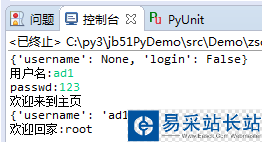本文实例讲述了Python使用装饰器模拟用户登陆验证功能。分享给大家供大家参考,具体如下:
# -*- coding:utf-8 -*-#!python3user_list = [ {'name':'ad1','passwd':'123'}, {'name':'ad2','passwd':'123'}, {'name':'ad3','passwd':'123'}, {'name':'ad4','passwd':'123'}]#初始状态,用来保存登陆的用户,client_dic = {'username':None,'login':False}#添加新功能def auth_func(func): def wrapper(*args,**kwargs): #参数检查,判断是否有用户登录,如果有,不用验证,直接执行函数的功能 if client_dic['username'] and client_dic['login']: res = func(*args,**kwargs) return res #输入用户名和密码 username = input('用户名:').strip() passwd = input('passwd:').strip() #对比列表,检查用户名和密码是否正确 for user_dic in user_list: if username == user_dic['name'] and passwd == user_dic['passwd']: client_dic['username'] = user_dic['name'] client_dic['login'] = True res = func(*args,**kwargs) return res else: print('用户名或者密码错误!') return wrapper@auth_funcdef index(): print("欢迎来到主页")@auth_funcdef home(name): print("欢迎回家:%s"%name)@auth_funcdef shoppping_car(): print('购物车里有[%s,%s,%s]'%('奶茶','妹妹','娃娃'))print(client_dic)index()print(client_dic)home('root')运行结果:

更多关于Python相关内容感兴趣的读者可查看本站专题:《Python数据结构与算法教程》、《Python编码操作技巧总结》、《Python函数使用技巧总结》、《Python字符串操作技巧汇总》及《Python入门与进阶经典教程》
希望本文所述对大家Python程序设计有所帮助。
新闻热点
疑难解答